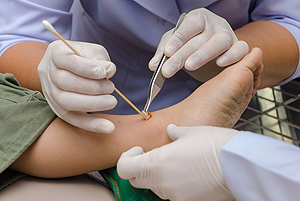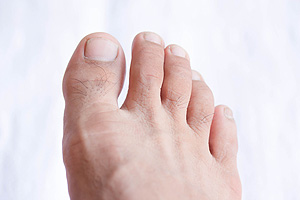Items filtered by date: February 2021
Is My Wound Infected?
Wounds can occur on any part of the body but they are especially common on the feet and lower legs, especially in people who have diabetes. Often, a combination of diabetes, poor circulation, and peripheral neuropathy can lead to slow-healing wounds forming on the lower limbs and going unnoticed for a period of time due to a lack of sensation. This can increase the chances of the wound becoming infected. Symptoms of infection include increased pain, redness, warmth, and swelling around the wound, yellow or green discharge or an unpleasant odor from the wound, fever or chills, aches, pain, nausea and vomiting. If you have wounds showing signs of infection, it is strongly recommended that you seek treatment as soon as possible. If you have diabetes and are prone to foot wounds, a podiatrist can help you maintain the health of your feet.
Wound care is an important part in dealing with diabetes. If you have diabetes and a foot wound or would like more information about wound care for diabetics, consult with Leonora Fihman, DPM from California. Our doctor will assess your condition and provide you with quality foot and ankle treatment.
What Is Wound Care?
Wound care is the practice of taking proper care of a wound. This can range from the smallest to the largest of wounds. While everyone can benefit from proper wound care, it is much more important for diabetics. Diabetics often suffer from poor blood circulation which causes wounds to heal much slower than they would in a non-diabetic.
What Is the Importance of Wound Care?
While it may not seem apparent with small ulcers on the foot, for diabetics, any size ulcer can become infected. Diabetics often also suffer from neuropathy, or nerve loss. This means they might not even feel when they have an ulcer on their foot. If the wound becomes severely infected, amputation may be necessary. Therefore, it is of the upmost importance to properly care for any and all foot wounds.
How to Care for Wounds
The best way to care for foot wounds is to prevent them. For diabetics, this means daily inspections of the feet for any signs of abnormalities or ulcers. It is also recommended to see a podiatrist several times a year for a foot inspection. If you do have an ulcer, run the wound under water to clear dirt from the wound; then apply antibiotic ointment to the wound and cover with a bandage. Bandages should be changed daily and keeping pressure off the wound is smart. It is advised to see a podiatrist, who can keep an eye on it.
If you have any questions, please feel free to contact our offices located in Encino and Brentwood, Los Angeles, CA . We offer the newest diagnostic and treatment technologies for all your foot care needs.
Properly Fitting Golf Shoes
 People who enjoy the sport of golf are often unaware of the importance of wearing the correct golf shoes. Research has shown the average golfer to walk approximately 10,000 steps, and it is beneficial to wear golf shoes that fit correctly. Using a Brannock device will help you to determine a proper foot measurement. If the second toe is longer than the big toe, it is suggested to increase by a half size. Additionally, it is advised to measure the feet at the end of the day, when they are at their largest. The inside of the shoes and the cleats can help you to understand what type of walker you are, and this is helpful in choosing the correct golf shoes. If you would like more information about how to purchase golf shoes, please consult with a podiatrist who can provide you with helpful information.
People who enjoy the sport of golf are often unaware of the importance of wearing the correct golf shoes. Research has shown the average golfer to walk approximately 10,000 steps, and it is beneficial to wear golf shoes that fit correctly. Using a Brannock device will help you to determine a proper foot measurement. If the second toe is longer than the big toe, it is suggested to increase by a half size. Additionally, it is advised to measure the feet at the end of the day, when they are at their largest. The inside of the shoes and the cleats can help you to understand what type of walker you are, and this is helpful in choosing the correct golf shoes. If you would like more information about how to purchase golf shoes, please consult with a podiatrist who can provide you with helpful information.
It is important to find shoes that fit you properly in order to avoid a variety of different foot problems. For more information about treatment, contact Leonora Fihman, DPM from California. Our doctor will treat your foot and ankle needs.
Proper Shoe Fitting
Shoes have many different functions. They cushion our body weight, protect our feet, and allow us to safely play sports. You should always make sure that the shoes you wear fit you properly in order to avoid injuries and deformities such as: bunions, corns, calluses, hammertoes, plantar fasciitis, stress fractures, and more. It is important to note that although a certain pair of shoes might be a great fit for someone else, that doesn’t mean they will be a great fit for you. This is why you should always try on shoes before buying them to make sure they are worth the investment. Typically, shoes need to be replaced ever six months to one year of regular use.
Tips for Proper Shoe Fitting
- Select a shoe that is shaped like your foot
- Don’t buy shoes that fit too tight, expecting them to stretch to fit
- Make sure there is enough space (3/8” to ½”) for your longest toe at the end of each shoe when you are standing up
- Walk in the shoes to make sure they fit and feel right
- Don’t select shoes by the size marked inside the shoe, but by how the shoe fits your foot
The shoes you buy should always feel as good as they look. Shoes that fit properly will last longer, feel better, and improve your way of life each day.
If you have any questions, please feel free to contact our offices located in Encino and Brentwood, Los Angeles, CA . We offer the newest diagnostic and treatment technologies for all your foot care needs.
What Is Capsulitis of the Second Toe?
Ligaments that surround the joint at the base of your second toe form a capsule. This capsule allows the joint to function properly. Capsulitis occurs when abnormal foot mechanics put excessive pressure on the ball of the foot and cause these ligaments to become inflamed. The symptoms of capsulitis may include pain in the ball of the foot, swelling in the ball of the foot or at the base of the toe, and difficulty walking barefoot. Left untreated, capsulitis can advance and cause the second toe to become unstable and cross over to lie on top of the big toe. While the second toe is most frequently affected, capsulitis can occur on the third and fourth toes as well. If you have symptoms of capsulitis, it is suggested that you see a podiatrist for treatment.
Foot Pain
Foot pain can be extremely painful and debilitating. If you have a foot pain, consult with Leonora Fihman, DPM from California. Our doctor will assess your condition and provide you with quality foot and ankle treatment.
Causes
Foot pain is a very broad condition that could be caused by one or more ailments. The most common include:
- Bunions
- Hammertoes
- Plantar Fasciitis
- Bone Spurs
- Corns
- Tarsal Tunnel Syndrome
- Ingrown Toenails
- Arthritis (such as Gout, Rheumatoid, and Osteoarthritis)
- Flat Feet
- Injury (from stress fractures, broken toe, foot, ankle, Achilles tendon ruptures, and sprains)
- And more
Diagnosis
To figure out the cause of foot pain, podiatrists utilize several different methods. This can range from simple visual inspections and sensation tests to X-rays and MRI scans. Prior medical history, family medical history, and any recent physical traumatic events will all be taken into consideration for a proper diagnosis.
Treatment
Treatment depends upon the cause of the foot pain. Whether it is resting, staying off the foot, or having surgery; podiatrists have a number of treatment options available for foot pain.
If you have any questions, please feel free to contact our offices located in Encino and Brentwood, Los Angeles, CA . We offer the newest diagnostic and treatment technologies for all your foot care needs.
What Are Shin Splints?
 A shin splint is a common injury that causes pain in the front or sides of the shin bone. The pain is typically apparent during or after walking, running, and other exercises that put stress on the shin bone. Shin splints can cause pain, tenderness, soreness, and mild swelling in the affected leg. If you have shin pain, you may be able to find some relief by resting and icing the shin. Shin splints are usually not indicative of an injury to the actual shin bone and often go away with rest. Sometimes, however, a shin splint can cause chronic pain and may progress to a stress fracture of the shin bone. For this reason, it is important to see a podiatrist, who can evaluate your condition and recommend the appropriate treatments.
A shin splint is a common injury that causes pain in the front or sides of the shin bone. The pain is typically apparent during or after walking, running, and other exercises that put stress on the shin bone. Shin splints can cause pain, tenderness, soreness, and mild swelling in the affected leg. If you have shin pain, you may be able to find some relief by resting and icing the shin. Shin splints are usually not indicative of an injury to the actual shin bone and often go away with rest. Sometimes, however, a shin splint can cause chronic pain and may progress to a stress fracture of the shin bone. For this reason, it is important to see a podiatrist, who can evaluate your condition and recommend the appropriate treatments.
Sports related foot and ankle injuries require proper treatment before players can go back to their regular routines. For more information, contact Leonora Fihman, DPM of California. Our doctor can provide the care you need to keep you pain-free and on your feet.
Sports Related Foot and Ankle Injuries
Foot and ankle injuries are a common occurrence when it comes to athletes of any sport. While many athletes dismiss the initial aches and pains, the truth is that ignoring potential foot and ankle injuries can lead to serious problems. As athletes continue to place pressure and strain the area further, a mild injury can turn into something as serious as a rupture and may lead to a permanent disability. There are many factors that contribute to sports related foot and ankle injuries, which include failure to warm up properly, not providing support or wearing bad footwear. Common injuries and conditions athletes face, including:
- Plantar Fasciitis
- Plantar Fasciosis
- Achilles Tendinitis
- Achilles Tendon Rupture
- Ankle Sprains
Sports related injuries are commonly treated using the RICE method. This includes rest, applying ice to the injured area, compression and elevating the ankle. More serious sprains and injuries may require surgery, which could include arthroscopic and reconstructive surgery. Rehabilitation and therapy may also be required in order to get any recovering athlete to become fully functional again. Any unusual aches and pains an athlete sustains must be evaluated by a licensed, reputable medical professional.
If you have any questions please feel free to contact our offices located in Encino and Brentwood, Los Angeles, CA . We offer the newest diagnostic and treatment technologies for all your foot and ankle needs.



